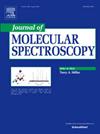在带源处探索吲哚二聚体结构:光谱气相红外分析
IF 1.3
4区 物理与天体物理
Q4 PHYSICS, ATOMIC, MOLECULAR & CHEMICAL
引用次数: 0
摘要
非共价相互作用,如氢键和π -π堆叠是分子结构的核心。本研究利用IR-UV双共振光谱和DFT计算研究了35238 cm−1波段附近的吲哚二聚体。红外光谱显示在3420 cm−1处有一个红移的NH拉伸,表明存在氢键。用B97D和B3LYP-D3进行计算分析,有利于N-H···π键结构。其中,我们认为具有N-H··π相互作用的倾斜几何形状与实验观测最一致。广谱图也表明存在多种低能异构体。本文章由计算机程序翻译,如有差异,请以英文原文为准。

Exploring indole dimer structures at the band origin: A spectroscopic gas phase IR analysis
Non-covalent interactions such as hydrogen bonding and π–π stacking are central to molecular architecture. This study investigates the indole dimer near the band origin at 35238 cm−1 using IR-UV double resonance spectroscopy and DFT calculations. The IDIR spectrum shows a red-shifted N![]() H stretch at 3420 cm−1, indicative of hydrogen bonding. Computational analyses with B97D and B3LYP-D3 functionals favor N–H‧‧‧π bonded structures. Among these, we assign a tilted geometry featuring N–H‧‧‧π interaction as the most consistent with experimental observations. The broad spectral profile also suggests the coexistence of multiple low-energy isomers.
H stretch at 3420 cm−1, indicative of hydrogen bonding. Computational analyses with B97D and B3LYP-D3 functionals favor N–H‧‧‧π bonded structures. Among these, we assign a tilted geometry featuring N–H‧‧‧π interaction as the most consistent with experimental observations. The broad spectral profile also suggests the coexistence of multiple low-energy isomers.
求助全文
通过发布文献求助,成功后即可免费获取论文全文。
去求助
来源期刊
CiteScore
2.70
自引率
21.40%
发文量
94
审稿时长
29 days
期刊介绍:
The Journal of Molecular Spectroscopy presents experimental and theoretical articles on all subjects relevant to molecular spectroscopy and its modern applications. An international medium for the publication of some of the most significant research in the field, the Journal of Molecular Spectroscopy is an invaluable resource for astrophysicists, chemists, physicists, engineers, and others involved in molecular spectroscopy research and practice.

 求助内容:
求助内容: 应助结果提醒方式:
应助结果提醒方式:


